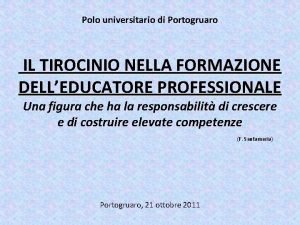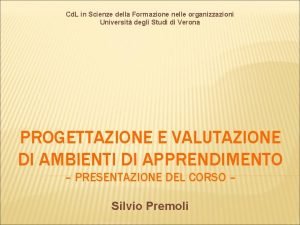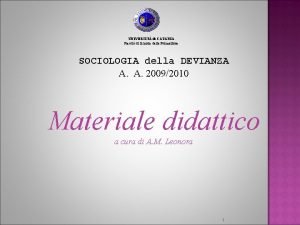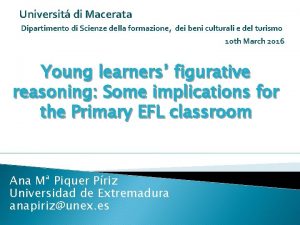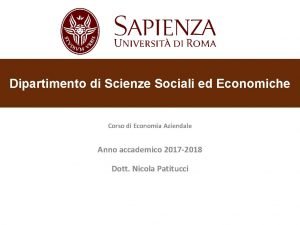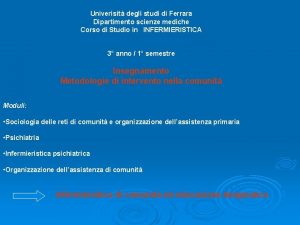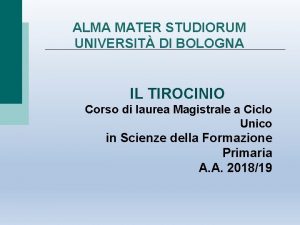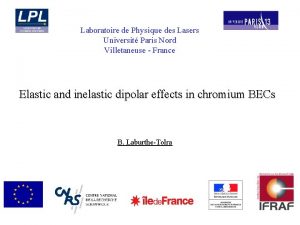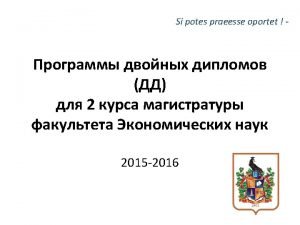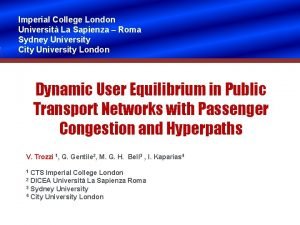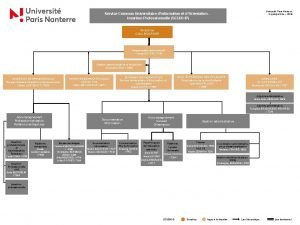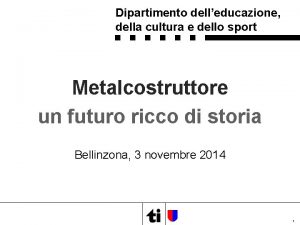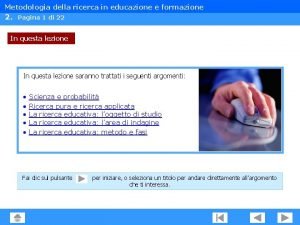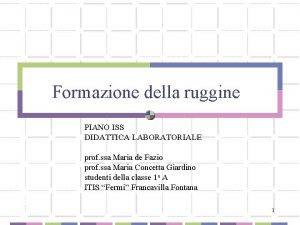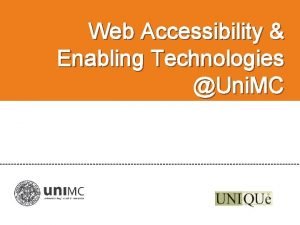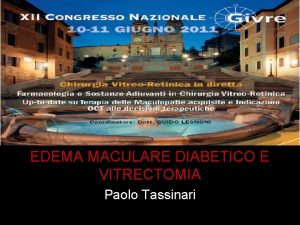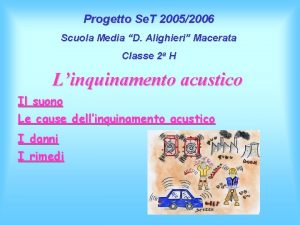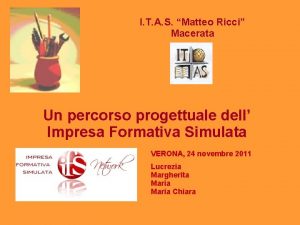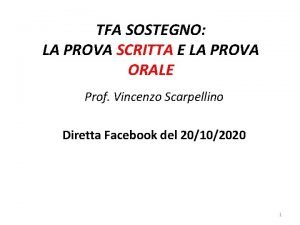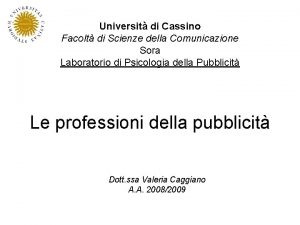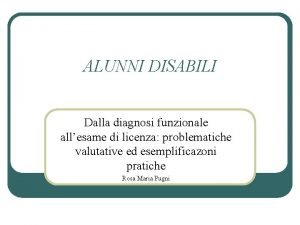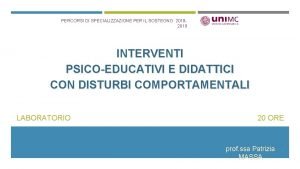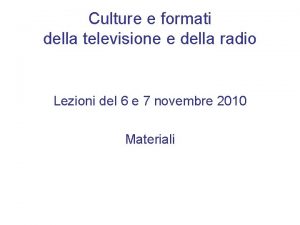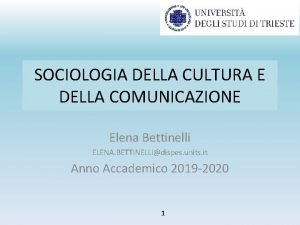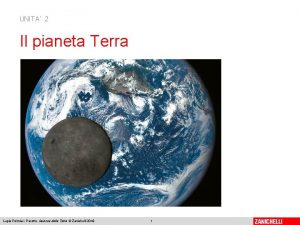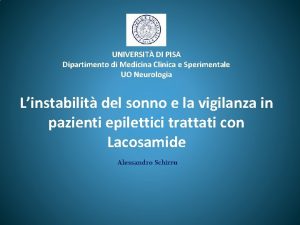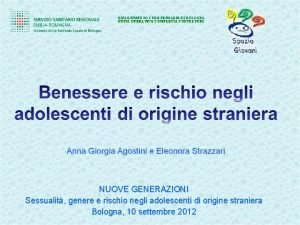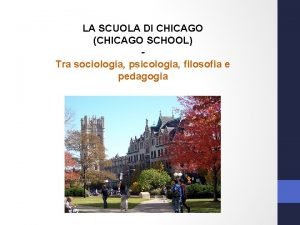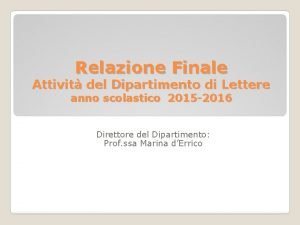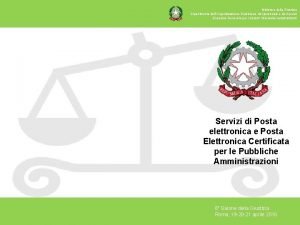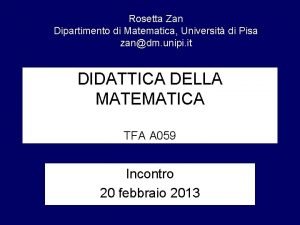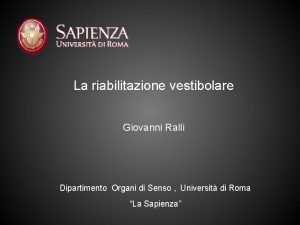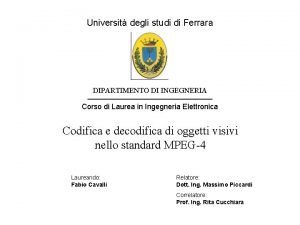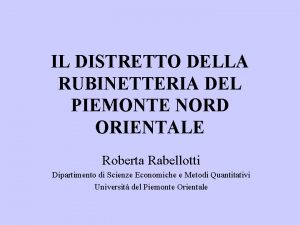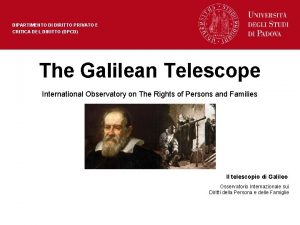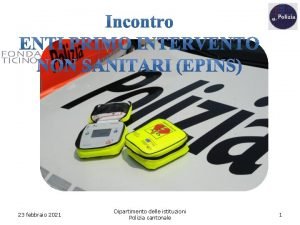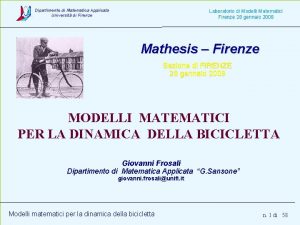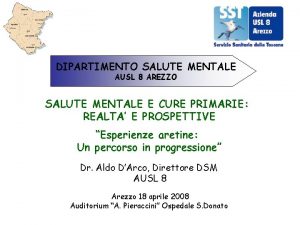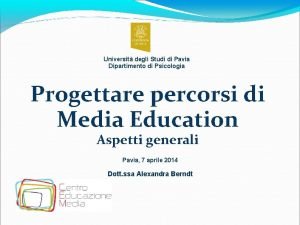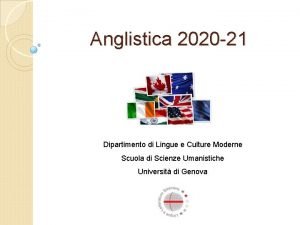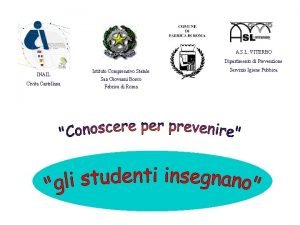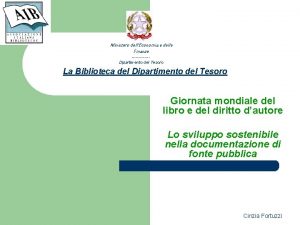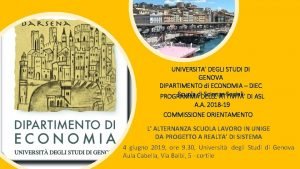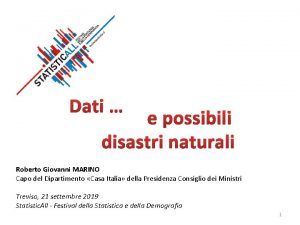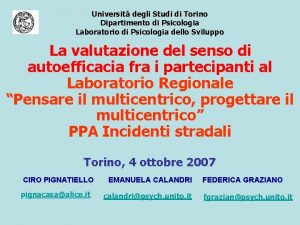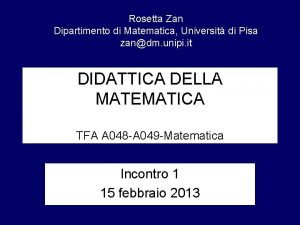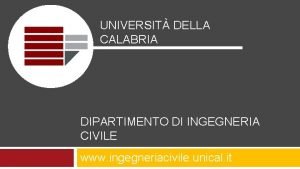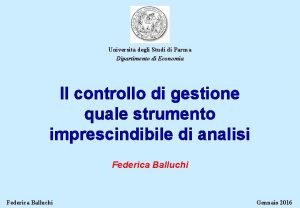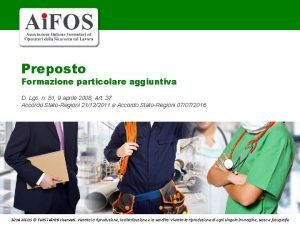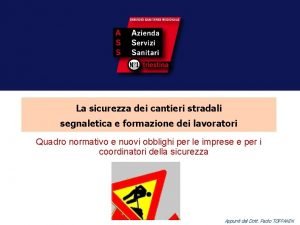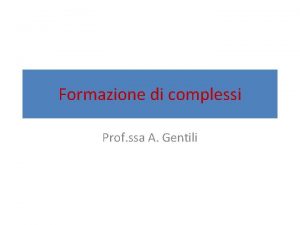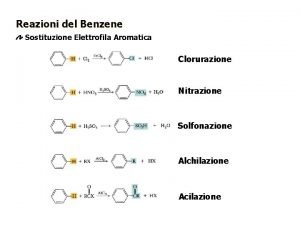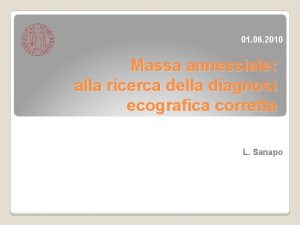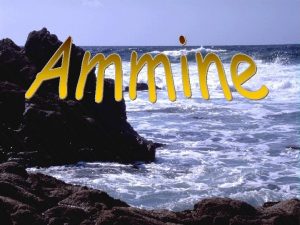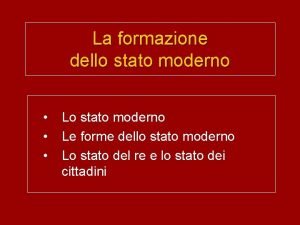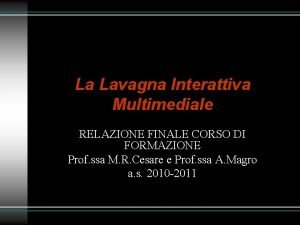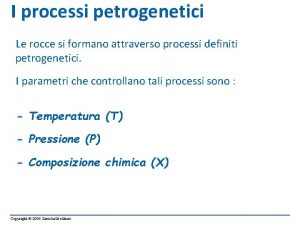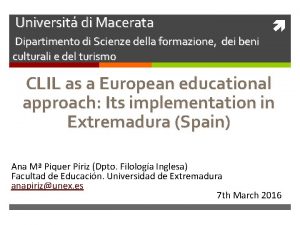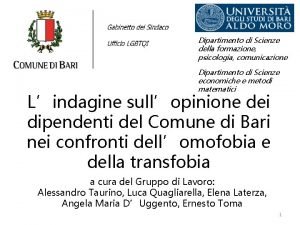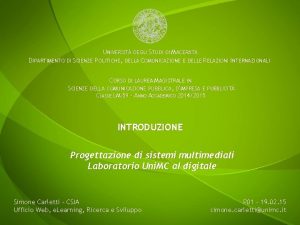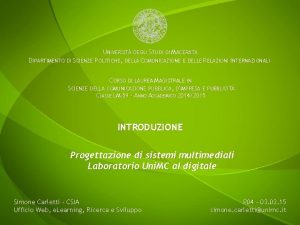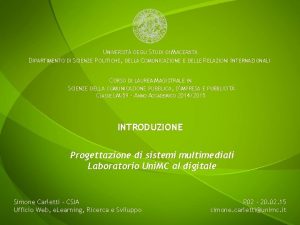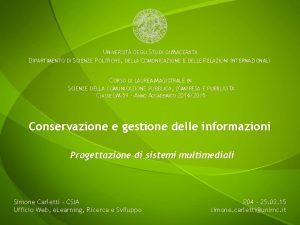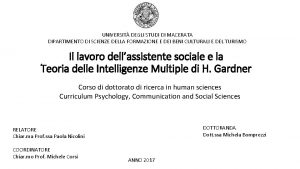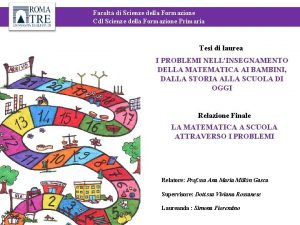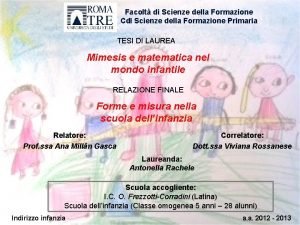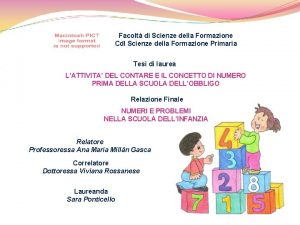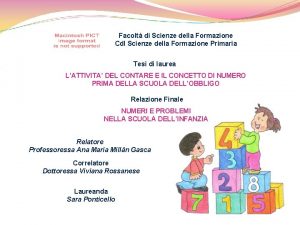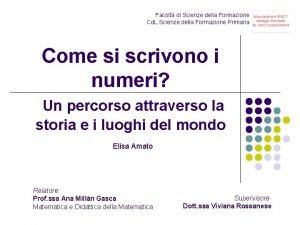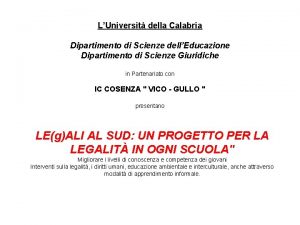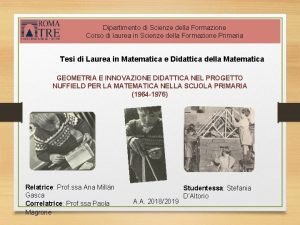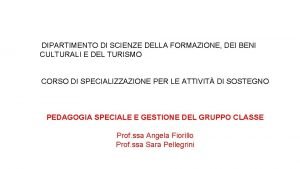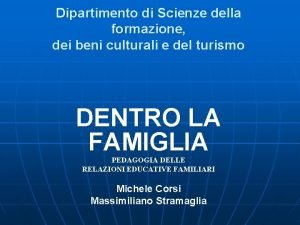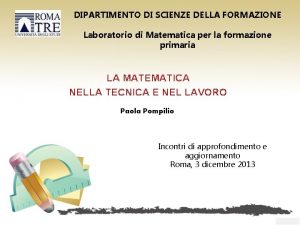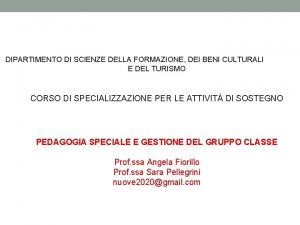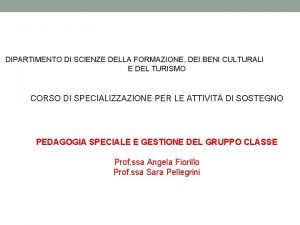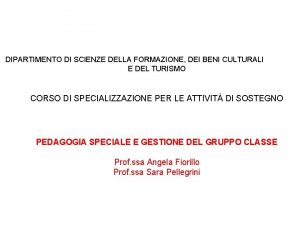Universit di Macerata Dipartimento di Scienze della formazione




































































































- Slides: 100

Universitá di Macerata Dipartimento di Scienze della formazione, dei beni culturali e del turismo 10 th March 2016 Young learners’ figurative reasoning: Some implications for the Primary EFL classroom Ana Mª Piquer Píriz Universidad de Extremadura anapiriz@unex. es

Can L 2 learners perceive the connections among the different meanings of a word?

Are there any connections among the different meanings of a word? Arbitrariness – motivation

The head of the bed El/La cabecero/a de la cama HEAD

Analogy + Metonymy Human body ---- watch BODY PART FOR FUNCTION HAND FOR POINTING The hands of a watch metaphor + metonymy HAND metonymy hand it to me metonymy give me a hand Metonymy BODY PART FOR FUNCTION (Barcelona 2000: 11) / THE HAND STANDS FOR THE ACTIVITY (Kövecses 2002: 207 -210) (HAND FOR PASSING THINGS /// HAND FOR HELPING)

Motivation and bodily/social experiences Motivation ◦ The connections between the different meanings of a word are not arbitrary but motivated Embodiment / Interaction with our surronding world ◦ This motivation is based on our physical, social and cultural experiences

Cognitive Semantics and Polysemy Revolution in the understanding of the phenomenon of polysemy: ◦ not arbitrary but motivated ◦ based on experiential correlations of a physical or a social nature ◦ structured via metaphor or metonymy New models for lexical networks (Lakoff 1987, Langacker 1990): ◦ central meaning connected to the others via metonymy, metaphor or image schemata (radially structured categories)

Figuration and L 2 acquisition METONYMY FIGURATIVE LANGUAGE METAPHOR OTHERS… Why is it important? L 2 ACQUISITION

Figuration and L 2 acquisition From a linguistic point of view, figurative language (metonymy, metaphor…) is present in our everyday speech L 2 learners need to master it From a psychological point of view, metonymy (associative reasoning) and metaphor (analogical reasoning) are mental mechanisms we use when we reason about language (our L 1, an L 2)

Applied Cognitive Linguistics

Applied Cognitive Linguistics Enhancing awareness of the figurative motivation for different types of linguistic expressions can aid their comprehension and memorisation

Teaching suggestions from Applied Cognitive Linguistics

Ponterotto (1994) Identifying conceptual metaphors

1. Underlie all the expressions in the following sentences which refer to the conceptual metaphor LIFE IS A GAMBLING GAME I’ll take my chances. The odds are against me He’s holding all the aces If you play your cards right, you can do it

1. Underlie all the expressions in the following sentences which refer to the conceptual metaphor LIFE IS A GAMBLING GAME I’ll take my chances. The odds are against me He’s holding all the aces If you play your cards right, you can do it

2. There are many ways of conceptualizing LOVE: ◦ LOVE IS A MAGNET ◦ LOVE IS MAGIC ◦ LOVE IS WAR LOVE IS MADNESS LOVE IS A PATIENT In the following examples, identify the metaphor that structures the expression: ◦ ◦ ◦ I’m crazy about her I was spellbound Their marriage is on its last legs I could feel the electricity between us He fled from her advances

2. There are many ways of conceptualizing LOVE: ◦ LOVE IS A MAGNET ◦ LOVE IS MAGIC ◦ LOVE IS WAR LOVE IS MADNESS LOVE IS A PATIENT In the following examples, identify the metaphor that structures the expression: ◦ ◦ ◦ I’m crazy about her (MADNESS) I was spellbound (MAGIC) Their marriage is on its last legs (A PATIENT) I could feel the electricity between us (MAGNET) He fled from her advances (WAR)

Lindstromberg (1996) Prepositions and images

Uses of ON

Uses of ON Literal Metaphorical The engine died on us

Deignan, Gabrys and Solska (1997) Raising awareness of metaphor in L 1 and L 2

Underlie the words in the following sentences which are associated with plants: 1. One more aspect of Hong Kong’s financial success is the flowering of architecture, art and culture. 2. Many young people, my daughter included, worked hard, joined school bands, teams, and clubs. Last week their labour bore fruit, and most achieve good exam results. 3. Massage isn’t a long-term cure for stress because it doesn’t get to the root of the problem. 4. As her career blossomed, she kept her personal and professional lives totally separated. 5. The new chairman has taken the company back to its American roots. 6. I had planted the seed of doubt in their minds.

1. One more aspect of Hong Kong’s financial success is the flowering of architecture, art and culture. 2. Many young people, my daughter included, worked hard, joined school bands, teams, and clubs. Last week their labour bore fruit, and most achieve good exam results. 3. Massage isn’t a long-term cure for stress because it doesn’t get to the root of the problem. 4. As her career blossomed, she kept her personal and professional lives totally separated. 5. The new chairman has taken the company back to its American roots. 6. I had planted the seed of doubt in their minds.

What do the plant words mean in these sentences? Use a dictionary to check your answers. Can you use any words for plants in your language with these meanings? Are words for plants used with any other meanings in your first language?

Lazar (2003) Meanings and metaphors




Rudzka-Ostyn (2003) Phrasal verbs

OUT: Eat or inviting to eat away from home OUT is leaving a container. Often verbs with out have a specific meaning in addition to motion in space. This is related to personal or social treatment, friendly or unfriendly.

ask…out - eat out – invite out – ousted…out of take… out - threw…out of (a) I would like to …you… to lunch. …you…(to a meal). I … you … to the party we are organizing this Friday. I might… …with you tonight, but unfortunately I can’t. (b) His wife…him… …the house The committee…him… … the club/office. a………… t………… i………… ea………… thr………… ou…………

The (a) sentences mean ‘to eat somewhere other than at one’s house, usually in a restaurant’ The (b) sentences mean ‘to cause somebody to lose his home/club membership/job. Glosses: (b) throw out: force to leave; ousted: removed as a member, kicked out of. Our home, the groups we are members of, our professional jobs are viewed as containers in(side) which we spend a lot of time. It is therefore normal that we use out once we move out of them.

Lindstromberg and Boers (2008) Teaching Chunks of Language. From noticing to rememebering

Idioms grouped by source domain Some examples: From ball games and track sports: ◦ the ball’s in your court, (score) an own goal, be off base… From the animal world: ◦ go belly up, a bone of contention, a carrot and stick method… From entertainment: ◦ take centre stage, perform a (delicate) balancing act, the curtain comes down…

Activity 1. 2. 3. 4. 5. Select a number of idioms that come from 3 different source domains (Make sure you can explain its meaning and origin: www. etymonline. com) Write each idiom on a large sheet Draw a Venn diagram (3 overlapping ovals labelled with the source domains) Hand-out one of the sheets to a pair of students Announce that the diagrams represent the three domains of experience that the idioms were originally used in (in their literal sense)

Activity 6. 7. 8. Ask each pair: a) To explain to their classmates what they think (or remember) the idioms means and its origin. b) To stick their sheet into the corresponding domain (i. e. oval) on the board (the overlapping parts enable students to place an idiom in more than one domain if they think that reflects its history or to avoid committing themselves to a definite choice) As sheets are stuck on the board, check the students’ ideas about where they should be placed, giving additional information about origin and meaning. ……………

Applied Cognitive Linguistics Lexis in general (Ponterotto 1994, Lazar 1996, 2003, Deignan et al. 1997, Littlemore and Mac. Arthur 2006, 2007, Mac. Arthur and Piquer-Píriz 2007, Piquer-Píriz 2008) Prepositions (Lindstromberg 1996, 1997) Phrasal verbs (Kövecses and Szabò 1996, Rudzka-Ostyn 2003, Condon 2008, Silvestre López (2009), Alejo et al (2010) Idioms (Boers, Stengers & Eyckmans (2007) Mac. Arthur and Boers (in press) Specialised discourse ◦ Economics (Boers 2000, Charteris-Black 2000, Herrera and White 2000, Alejo (2010) ◦ Architecture (Caballero 2003) ◦ Wine (Caballero and Suárez-Toste 2008)

Young EFL learners? n Adolescents or adult learners have been the main focus of study n However, EFL is introduced at ever younger ages in many countries n Can young learners also perceive the connections of the figurative extensions of core lexemes and, therefore, benefit from this in their language learning process?

Children (Piquer-Píriz 2005, 2010)

Studies carried out in two domains Body parts ◦ hand: hand give me a hand, the hands of watch, hand it to me ◦ mouth: mouth not open one’s mouth ◦ head: head the head of a bed/ a hammer/ the stairs/ a line of cars n. Temperature terms n n warm cold when applied to colours personality

Research questions RQ 1: Are young (5 -11) Spanish learners of EFL able to identify semantic extensions of English core lexical items, the prototypical meaning of which they know from their English lessons? RQ 2: What kind of reasoning is involved in the children’s recognition of these figurative senses?

Participants Spanish learners of EFL attending two state schools in Extremadura (western Spain) Variety of social and economic backgrounds Number and ages ◦ Body parts 5 -, 7 -, 9 - and 11 - year-olds 148 (77 girls and 71 boys) ◦ Temperature terms 6 -, 8 -, and 10 -year-olds 142 (75 girls and 67 boys)

Considerations about the design of the studies n Classroom-like context • Natural context • Classroom dynamics promotes negotiation of meaning (Vygotsky 1962; Wood, Bruner and Ross 1976 or Cameron 1996, 2003) n Tasks adapted to the children • Avoidance of meta-language • Written forms kept to a minimum • Warm-up activities

Stimuli n Varied stimuli used in the five studies n. Oral input: e. g. In study 1, a situation was presented to them with optional answers. n. Short stories: Using story strips (study 2). n. Visuals: e. g. laminated coloured cards (study 4), dolls (study 5), photographs (study 3).

Oral input Study 1. Case 1. Give me a hand “Si necesito que me ayudéis a hacer algo, ¿cómo creéis que os lo voy a pedir en inglés? ” (If I need your help to do something, how do you think I’m going to ask for it in English? ) “Give me a head, give me a hand or give me a mouth”

Strip 1

Strip 2

Strip 3

The head of a bed

The head of a hammer

The head of a line of cars

The head of the stairs

Procedure Grouping of subjects ◦ Studies 1, 3, 4 and 5 (groups of 5) ◦ Study 2 (whole class activity) Children asked to identify the semantic extensions and explain their answers ◦ Interviewer takes the role of teacher Children’s answers and explanations were tape-recorded and transcribed

Results

Quantitative analysis

Study 1

Study 2

Study 3. The head of a line of cars

Study 3. The head of a bed

Study 3. The head of the stairs

Study 3. The head of a hammer

Study 4. Warm colours

Study 4. Cold colours

Study 5

Study 5

Qualitative analysis

Extensive figurative reasoning Often based on: ◦ their bodily experiences (Body parts) ◦ their observation of / interaction with the environment (Colours) ◦ Their own experiences and their more/less developed knowledge of a particular domain (Personality)

Metonymy C: “en la almohada porque la cabeza se pone en la almohada” C: on the pillow because we lay our head on the pillow (5 -year-old)

Creative simile C: “porque los dedos de las manos se parecen a las agujas” C: because the fingers of your hand look like needles [the hands of the watch]) (7 -year-old)

Metaphor C: “porque es el final de la escalera R: y eso ¿qué tiene que ver con ‘head’? C: que es el final de la escalera – está arriba del cuerpo” C: because it’s the end of the staircase R: and what’s that got to do with ‘head’? C: ‘cos it’s the end of the stairs – it’s on top of the body (5 -year-old)

Metaphor C 1: “porque también cuando está anocheciendo se pone algunas veces detrás de las nubes se pone naranja (C 2: y morao [morado] – y morao [morado] un poquinino [poquito]) (C 3: ¿Al amanecer o al anochecer? ) (C 1: a los dos, a los dos) (C 2: una especie de rosa)” C 1: because at dusk it sometimes hides behind the clouds and gets orange (C 2: and purple – and a bit purple) (C 3: at dawn or at dusk? ) (C 1: both, both) (C 2: pinkish) (8 -year-olds)

Metaphor C: ‘the fat lady’ es la ‘cold’ porque es fría y severa y que no quiere ayudar a nadie y ‘a thin lady’ pues es más buena y creo que es warm porque le ayuda – no sé – que es más acogedora o como se diga” C: the fat lady is the cold one because she’s cold and severe and she doesn’t want to help anybody and ‘a thin lady’ is betternatured and I think she’s warm because she helps him – I don’t know – she’s more welcoming or whatever the word is (10 -year-old)

Can you think of any possible applications of these findings in the Primary EFL classroom?

Some CL-oriented proposals to teach the preposition ON to very young learners (Piquer-Píriz, 2006)

Total Physical Response (TPR) activities: Illustrating the senses of support and attachment Drawing, displaying and decorating: Illustrating the sense of attachment to different surfaces Activitities related to clothes (daily routines, dressing up and puppets): Illustrating the senses of support and attachment

Applied Cognitive Linguistics and young EFL learners: Some issues to explore

Specific pedagogical implications of these findings. Some issues to consider: ◦ Grading of input in early EFL syllabi (age factor) ◦ Exploration of the long-term advantages of encouraging figurative reasoning in the L 2 classroom ◦ Implications for the learning not only of vocabulary but also grammar Role of children’s ‘knowledge of the world’ Exploration semantic fields other than temperature terms or body parts

Adult learners (Piquer-Píriz and Boers 2010)

Study to analyse individual differences in L 2 figurative language processing: 1. RQ 1: What kind of reasoning do EFL learners employ when explaining different types of figurative meanings? 2. RQ 2: Does their style of memory (imager – verbaliser) influence their preference for different types of reasoning?

Study to analyse individual differences in L 2 figurative language processing: 1. RQ 1: What kind of reasoning do EFL learners employ when explaining different types of figurative meanings? 2. RQ 2: Does their style of memory (imager – verbaliser) influence their preference for different types of reasoning?

Participants 22 university students: ◦ Spanish Primary school teacher trainees ◦ Sophomores ◦ Sex: 18 females 4 males

Stimuli 10 figurative expressions o metonymically based figurative extensions (hand it to me, the head of the stairs, to have a big mouth) o metaphorically based semantic extensions (colours (red/green), a warm person) o figurative meanings of prepositions: write down, under the influence o an alliterative simile: as fit as a fiddle o a figurative expression containing assonance: go with the flow

Procedure Think-aloud protocol: ◦ Items displayed on a screen ◦ Learners asked to motivate the meaning of the expressions: ◦ E. g. “Why do we say in English ‘hand it to me’ to mean ‘pass/give something to me’ when we ask for things? ” ◦ Answers recorded by them and transcribed

RQ 1. Types of verbal reasoning

Analysis 4 raters Categorisation of answers: ◦ ‘CL-style’ motivations (they reflect metonymical or metaphorical verbal reasoning) ◦ write down E. g. : “because when we write something we write it down in our paper that is on the table and is like down – you have to put your hand down to write” ◦ warm person E. g. : “a friendly person has a warm personality because if a person is friendly is always with you and gives you his or her support and gives you warmth”

Analysis Categorisation of answers: ◦ Paraphrasing ◦ E. g. “I think that a person has a warm personality – is a person very friendly” ◦ Personal association ◦ E. g. “in my opinion green is a cold colour because when I see it it gives me the sensation that something is cold I don't know why but I think because I relate it I relate the green colour with something cold” ◦ L 1 transfer ◦ E. g. “[under the influence] because it is the same as in Spanish- ‘bajo’ ” ◦ Others: avoidance, abandonment, misunderstanding

RQ 1. Types of verbal reasoning

Adolescents (Piquer-Píriz, Mac. Arthur and Alejo 2010)

Research Questions RQ 1: Are there differences between the way in which CLIL and NON-CLIL students respond to figurative language ? RQ 2: Are there qualitative and quantitative differences in the way these two groups of students respond to familiar and novel figurative language in the L 2? RQ 3: What effect if any does the form of the figurative expression have on the learners’ responses?

Research Questions RQ 1: Are there differences between the way in which CLIL and NON-CLIL students respond to figurative language ? RQ 2: Are there qualitative and quantitative differences in the way these two groups of students respond to familiar and novel figurative language in the L 2? RQ 3: What effect if any does the form of the figurative expression have on the learners’ responses?

Method (i) Participants ◦ 2 groups of Spanish students in their 3 rd year of compulsory secondary education (15 years old) ◦ CLIL group (instructed in a CLIL programme for, at least, 3 academic years) Sex: 9 girls 6 boys Sex: 3 girls 12 boys ◦ non-CLIL group (average EFL tuition)

Method (ii) Stimuli (8 items) ◦ Same motivation, similar realisations (transport, long face) ◦ Same motivation, different realisation (go up) ◦ Similar motivation, different sense and realisation (hand, shoulder, to face) ◦ Novel ([write] down, reach its peak)

Method (iii) Procedure ◦ Items placed in a short context (1 or 2 sentences), displayed on a screen ◦ Figurative items in bold type ◦ Learners asked a) to explain the meaning of the word/expression b) to explain why they think these words are used in this way in English ◦ Answers recorded and transcribed

Method (iv) 3 raters Categorisation of answers: ◦ blank: the student could not say anything or simply translated into Spanish or paraphrased the expression ◦ Identification: the student identifies the two domains (in the case of metaphorical expressions) or the metonymic link but does not motivate the connection ◦ Semantic elaboration: the student motivates a metaphorical or metonymical connection (it can be incorrect in some cases)

Quantitative results

Quantitative results

long face “significa que cuando estamos tristes…eh… no no…no… no ponemos en contracción los músculos de la cara y se vuelve un poco más larga que cuando estamos sonriendo” it means that when we are sad. . . errr. . . we don’t. . . don’t contract the muscles in our face and it becomes longer than when we are smiling

hand it to me “significa ‘me lo dio’ ‘me lo acercó’ porque siempre se refiere a algo que tú pasas con la mano” it means ‘he gave it to me’ ‘he brought it to me’ because it refers to something that you give with your hand

to shoulder “yo creo que viene de que… antes pues la mayoría de las cosas se llevaban al hombro entonces pues 'hacerse cargo' quiere decir que va a ser el encargado de preocuparse de la educación de su hermano pequeño” I think it comes from. . . in the past most things were carried on the shoulder so ‘be in charge’ means he will be in charge of worrying about his youngest brother’s education

 Scienze della formazione portogruaro
Scienze della formazione portogruaro Quaderno di tirocinio scienze della formazione primaria
Quaderno di tirocinio scienze della formazione primaria Language acquisition and language learning
Language acquisition and language learning Lifedeep learning significato
Lifedeep learning significato Scienze della formazione primaria catania
Scienze della formazione primaria catania Scienze della formazione
Scienze della formazione Scienze della formazione savigliano
Scienze della formazione savigliano Dipartimento di scienze mediche
Dipartimento di scienze mediche Dipartimento scienze economiche e aziendali
Dipartimento scienze economiche e aziendali Totalmente compensatorio
Totalmente compensatorio Scienze formazione primaria bologna
Scienze formazione primaria bologna Universit
Universit Rotterdam school of economics
Rotterdam school of economics Universit of london
Universit of london Universit sherbrooke
Universit sherbrooke Organigramme nanterre
Organigramme nanterre Dipartimento dell'educazione della cultura e dello sport
Dipartimento dell'educazione della cultura e dello sport Sindefil
Sindefil Formazione della ruggine
Formazione della ruggine Mc elearning
Mc elearning Maculopatia laser macerata
Maculopatia laser macerata Alighieri macerata
Alighieri macerata Itas matteo ricci macerata
Itas matteo ricci macerata Domanda motivazionale tfa sostegno cosa rispondere
Domanda motivazionale tfa sostegno cosa rispondere Scienze psicosociali della comunicazione
Scienze psicosociali della comunicazione Competenz
Competenz Moti millenari zanichelli
Moti millenari zanichelli 3 principi fichte
3 principi fichte Ritopei
Ritopei Soluzioni il racconto della chimica
Soluzioni il racconto della chimica F92 disturbi misti della condotta e della sfera emozionale
F92 disturbi misti della condotta e della sfera emozionale Il racconto della chimica e della terra
Il racconto della chimica e della terra Culture e formati della televisione e della radio
Culture e formati della televisione e della radio Fasi lavorazione seta
Fasi lavorazione seta La coccinella rossella
La coccinella rossella Soluzioni il racconto delle scienze naturali
Soluzioni il racconto delle scienze naturali La mia bambina con la palla in mano
La mia bambina con la palla in mano Elena bettinelli
Elena bettinelli Soluzioni il racconto della chimica e della terra
Soluzioni il racconto della chimica e della terra Prove della sfericità della terra
Prove della sfericità della terra Le proprietà delle soluzioni zanichelli capitolo 13
Le proprietà delle soluzioni zanichelli capitolo 13 Soluzioni il racconto della chimica e della terra
Soluzioni il racconto della chimica e della terra Prove della sfericità della terra zanichelli
Prove della sfericità della terra zanichelli Dipartimento del tesoro
Dipartimento del tesoro Dipartimento di medicina clinica e sperimentale pisa
Dipartimento di medicina clinica e sperimentale pisa Dipartimento cure primarie bologna
Dipartimento cure primarie bologna Scuola di chicago esponenti
Scuola di chicago esponenti Relazione finale coordinatore dipartimento
Relazione finale coordinatore dipartimento Dipartimento organizzazione giudiziaria
Dipartimento organizzazione giudiziaria Sotto un ponte passano due anatre
Sotto un ponte passano due anatre Dipartimento di psicologia vanvitelli
Dipartimento di psicologia vanvitelli Esercizi vestibolo oculari
Esercizi vestibolo oculari Dipartimento ingegneria ferrara
Dipartimento ingegneria ferrara Dipartimento medicina perugia
Dipartimento medicina perugia Dipartimento di chimica bari
Dipartimento di chimica bari Dipartimento ingegneria trento
Dipartimento ingegneria trento Biblioteche unipr
Biblioteche unipr Nord (dipartimento)
Nord (dipartimento) Dipartimento di diritto privato e critica del diritto
Dipartimento di diritto privato e critica del diritto Gecos protezione civile
Gecos protezione civile Dipartimento delle istituzioni
Dipartimento delle istituzioni Fulvia furinghetti
Fulvia furinghetti Dipartimento di matematica firenze
Dipartimento di matematica firenze Salute mentale arezzo
Salute mentale arezzo Dipartimento psicologia pavia
Dipartimento psicologia pavia Dipartimento farmacia unical
Dipartimento farmacia unical Dipartimento di economia pisa
Dipartimento di economia pisa Dipartimento lingue unige
Dipartimento lingue unige Dipartimento prevenzione asl viterbo
Dipartimento prevenzione asl viterbo Dipartimento del tesoro
Dipartimento del tesoro Dipartimento economia genova
Dipartimento economia genova Dipartimento di fisica ferrara
Dipartimento di fisica ferrara Dipartimento casa italia
Dipartimento casa italia Dipartimento chimica unipv
Dipartimento chimica unipv Dipartimento di chimica pavia
Dipartimento di chimica pavia Dipartimento di psicologia torino
Dipartimento di psicologia torino Rosetta zan didattica della matematica
Rosetta zan didattica della matematica Cicognani alessandro bologna
Cicognani alessandro bologna Dipartimento ingegneria civile unical
Dipartimento ingegneria civile unical Unipr dipartimento economia
Unipr dipartimento economia Scuola centrale formazione
Scuola centrale formazione Pinocchio romanzo di formazione
Pinocchio romanzo di formazione Slide formazione generale lavoratori ppt
Slide formazione generale lavoratori ppt Formazione del passato prossimo
Formazione del passato prossimo Venere vesta e pallade
Venere vesta e pallade Slide corso formazione segnaletica stradale
Slide corso formazione segnaletica stradale Tabella costanti di formazione complessi
Tabella costanti di formazione complessi Solfonazione benzene meccanismo
Solfonazione benzene meccanismo Cfp legnano
Cfp legnano Corso mongodb
Corso mongodb Classificazione iota ecografia
Classificazione iota ecografia Ammina
Ammina Formazione milam
Formazione milam Il processo di formazione dello stato moderno
Il processo di formazione dello stato moderno Scuola di formazione tecnocasa
Scuola di formazione tecnocasa Relazione finale scuola primaria compilata
Relazione finale scuola primaria compilata Il romanzo di formazione e psicologico
Il romanzo di formazione e psicologico Slide corso preposto ppt
Slide corso preposto ppt Serie di bowen zanichelli
Serie di bowen zanichelli Il bildungsroman
Il bildungsroman Fise materiale didattico
Fise materiale didattico
